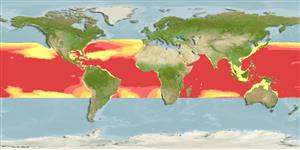Common names from other countries
>
Myctophiformes (Lanternfishes) >
Myctophidae (Lanternfishes) > Diaphinae
Etymology: Diaphus: Greek, dis, dia = through + Greek, physa, phyo = to beget, to have as offspring (Ref. 45335).
Environment: milieu / climate zone / depth range / distribution range
Écologie
marin bathypélagique; océanodrome (Ref. 51243); profondeur 0 - 8000 m (Ref. 58018). Deep-water; 43°N - 27°S
Eastern Atlantic: between 30°N and about 19°N and between 7°N and 11°S (uncommon over the Mauritanian Upwelling Region). Western Atlantic: USA in the Gulf Stream to Brazil. Indian Ocean: 7°N and 23°S; Agulhas Current (Ref. 4066). Western Pacific: to 35°N in Kuroshio and Tushima currents. Eastern Pacific: 8° and 12°S.
Length at first maturity / Taille / Poids / Âge
Maturity: Lm 7.1, range 5 - 7.7 cm
Max length : 9.0 cm SL mâle / non sexé; (Ref. 4479)
Épines dorsales (Total) : 0; Rayons mous dorsaux (Total) : 14 - 15; Épines anales: 0; Rayons mous anaux: 16 - 17.
Oceanic and mesopelagic, found between 375-750 m during the day; between 40-225 m at night (maximum abundance at 100 m depth) (Ref. 4479).
Life cycle and mating behavior
Maturities | Reproduction | Spawnings | Egg(s) | Fecundities | Larves
Hulley, P.A., 1990. Myctophidae. p. 398-467. In J.C. Quero, J.C. Hureau, C. Karrer, A. Post and L. Saldanha (eds.) Check-list of the fishes of the eastern tropical Atlantic (CLOFETA). JNICT, Lisbon; SEI; Paris; and UNESCO, Paris. Vol. 1. (Ref. 4479)
Statut dans la liste rouge de l'IUCN (Ref. 130435)
CITES (Ref. 128078)
Not Evaluated
Menace pour l'homme
Harmless
Utilisations par l'homme
Outils
Articles particuliers
Télécharger en XML
Sources Internet
Estimates based on models
Preferred temperature (Ref.
115969): 1.7 - 4.3, mean 2.3 (based on 6168 cells).
Phylogenetic diversity index (Ref.
82804): PD
50 = 0.5000 [Uniqueness, from 0.5 = low to 2.0 = high].
Bayesian length-weight: a=0.00813 (0.00444 - 0.01488), b=3.06 (2.90 - 3.22), in cm Total Length, based on LWR estimates for this species & Genus-body shape (Ref.
93245).
Niveau trophique (Ref.
69278): 3.0 ±0.00 se; based on food items.
Résilience (Ref.
120179): Haut, temps minimum de doublement de population inférieur à 15 mois (Preliminary K or Fecundity.).
Fishing Vulnerability (Ref.
59153): Low vulnerability (10 of 100).
